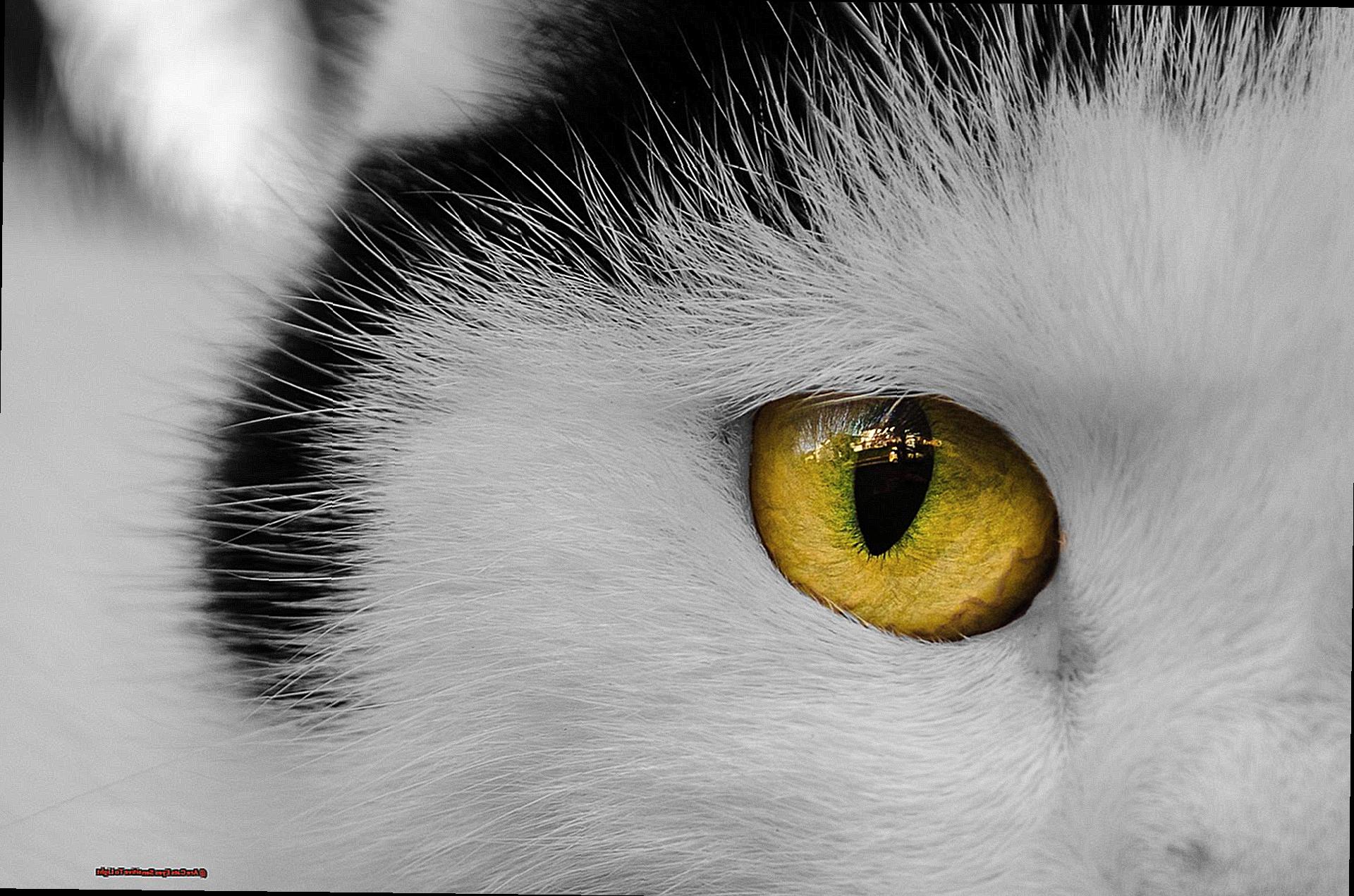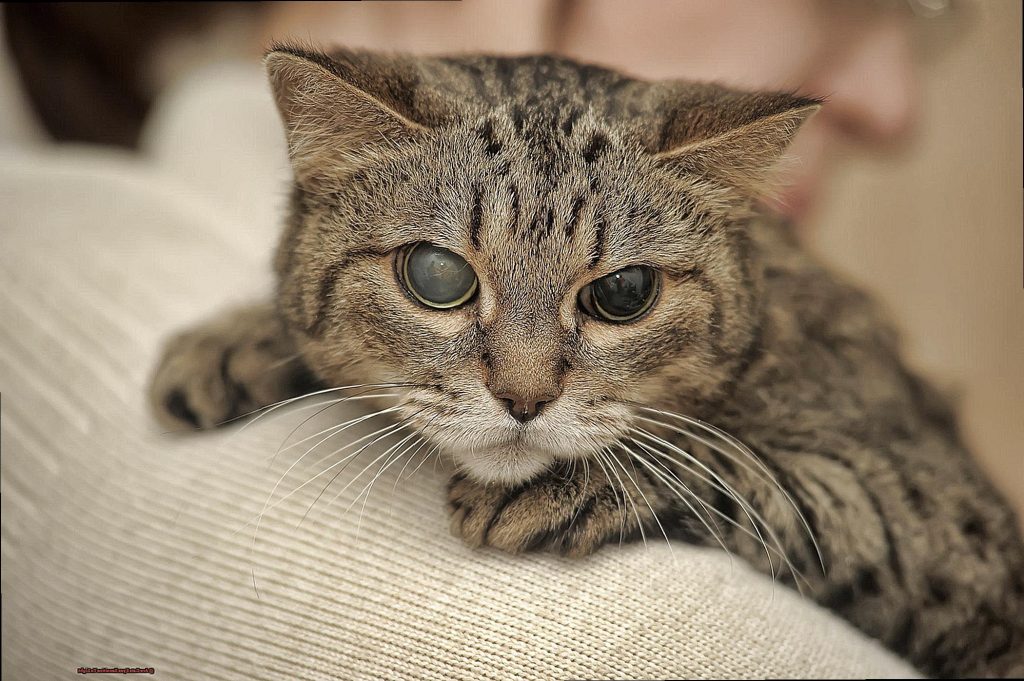Cats are mysterious creatures with sharp senses, but did you know that their eyes are also incredibly sensitive to light?
If you’re a cat owner, you’ve probably noticed your feline friend’s love for soaking up the sun. But have you ever wondered why they’re drawn to bright, sunny spots?
It’s all thanks to their remarkable eyesight. Cats have specially designed eyes that make them highly sensitive to light, allowing them to see in the dark and effortlessly maneuver through their surroundings.
Let’s dive deeper into the fascinating world of cats’ sensitive eyes.
Are Cats Eyes Sensitive To Light?
Contents
Cats are known for their keen senses, especially their exceptional vision. As natural hunters, cats have evolved to have highly sensitive eyes that allow them to see in low light conditions.
However, this sensitivity also means that cats can be easily overwhelmed by bright lights. As a cat expert, I have seen firsthand how important it is for cat owners to understand their pets’ sensitivity to light and take appropriate measures to ensure their comfort and well-being.
Tapetum Lucidum: The Secret Behind Cats’ Night Vision
One of the main reasons for cats’ sensitivity to light is their tapetum lucidum, a reflective layer of cells located behind the retina. This layer acts like a mirror, reflecting light back into the eye and giving cats improved night vision. This is why their eyes appear to glow in the dark when light is shone on them. The tapetum lucidum also amplifies light, making it easier for cats to see in dim lighting. While this is beneficial in low light conditions, it can be uncomfortable for cats in bright environments.
Age, Breed, and Eye Color: Factors That Affect Sensitivity
Aside from the tapetum lucidum, other factors can also impact a cat’s sensitivity to light. Age is one of them – just like humans, older cats may have a harder time adjusting to changes in lighting and may require more time to adapt. Certain breeds with larger eyes, such as Siamese or Persian cats, may also be more prone to sensitivity to light due to their larger pupils. Additionally, cats with lighter colored eyes, such as blue or green, tend to be more sensitive to light than those with darker colored eyes.
Providing a Comfortable Environment for Your Cat
As responsible pet owners, it is important for us to provide a comfortable environment for our furry companions. This includes avoiding prolonged exposure to bright lights and providing shaded areas for outdoor cats. If your cat shows signs of discomfort or squints in well-lit areas, it may be a sign that they are sensitive to light. In such cases, it is best to provide a dimmer environment for them to relax in.
Understanding the Tapetum Lucidum
They can navigate through a dimly lit room with ease, chase after a toy in the dark, and even hunt for prey at night. But have you ever wondered how they do it? The answer lies in a specialized layer of tissue in their eyes called the tapetum lucidum.
What is the Tapetum Lucidum?
The tapetum lucidum (Latin for “bright tapestry”) is a reflective layer of tissue found behind the retina in the eyes of many animals, including cats. Its main function is to enhance an animal’s vision in low light conditions by reflecting light back through the retina, giving them a second chance to capture and process the light. This is what gives cats their exceptional night vision and that eerie green or yellow glow in their eyes when caught in the headlights.
How Does it Work?
To understand how the tapetum lucidum works, let’s take a closer look at a cat’s eye anatomy. Similar to humans, cats have a cornea, iris, lens, and retina. However, they also have this additional layer of tissue behind the retina. When light enters a cat’s eye, it passes through the cornea and iris before reaching the lens. The lens then focuses the light onto the retina, where it is converted into signals and sent to the brain for processing.
But here’s where things get interesting. Any light that isn’t absorbed by the retina gets reflected back onto the tapetum lucidum, which acts like a mirror and bounces the light back through the retina. This provides cats with a second chance to capture and process the light, making them more sensitive to low light environments.
Why Do Cats Have It?
The tapetum lucidum is not unique to cats; many nocturnal animals have this specialized layer in their eyes. However, cats have a larger and more developed tapetum lucidum compared to humans, giving them a significant advantage in the dark. This is why cats can see more clearly and efficiently in low light conditions than we can.
Differences Between Cat and Human Eyes
Larger pupils, a reflective layer behind the retina, and a third eyelid – these are just a few of the unique adaptations that contribute to the differences between cat and human eyes. Let’s break it down and explore how each of these factors plays a role in sensitivity to light.
Larger Pupils
It’s no secret that cats have larger pupils than humans. But did you know that this is actually an advantage when it comes to their vision? The larger the pupil, the more light can enter the eye. This allows cats to see better in low-light conditions, making them excellent hunters in the dark.
Reflective Layer
The tapetum lucidum – a layer of reflective cells behind the retina – is one of the most fascinating features of a cat’s eye. This layer acts like a mirror, giving them a second chance at capturing and processing light. It also explains why cats’ eyes appear to glow in the dark. This adaptation not only enhances their night vision but also contributes to their seemingly sensitive reaction to light.
Third Eyelid
You may have noticed your cat’s third eyelid, also known as the nictitating membrane, which can occasionally be seen when they blink rapidly. This thin layer of tissue serves as a protective layer against bright light or debris, giving them an added level of defense against potential eye irritants.
Rods vs. Cones
Cats have a higher concentration of rods – cells responsible for detecting light and dark – in their retina, while humans have a higher concentration of cones – cells responsible for color vision. This means cats are more sensitive to changes in light levels, while humans have a wider range of color vision.
How Cats See in Low Light Conditions
Are you constantly amazed by your cat’s ability to navigate through dark rooms with ease, while you’re struggling to find the light switch? Well, you’re not alone. Cats have a natural advantage when it comes to seeing in low light conditions, making them excellent hunters at night. So, how exactly do they do it? Let’s take a closer look.
A Unique Eye Structure
One of the main reasons cats can see in low light is their unique eye structure. Their eyes are larger than ours, with a bigger cornea and pupil, allowing more light to enter. Additionally, cats have a reflective layer called the tapetum lucidum behind their retina, which helps to amplify incoming light and improve their vision in dimly lit environments. This layer is also responsible for the famous glow of cats’ eyes in the dark.
Multiple Chances for Image Processing
The tapetum lucidum not only amplifies light but also reflects it back through the retina, giving cats multiple chances to process an image. This means that even with limited light, cats can still see and make sense of their surroundings.
More Sensitive Rod Cells
Cats also have a higher number of rod cells in their retina compared to humans. These cells are more sensitive to light and are responsible for night vision. With this adaptation, cats’ eyes are about six times more sensitive to light than human eyes, giving them an advantage in low light conditions.
Dilated Pupils
Another advantage cats have is their ability to dilate their pupils in low light conditions. This lets in more light and expands their range of vision. However, this sensitivity to light can also be a disadvantage for cats when exposed to bright lights, causing discomfort or even temporary blindness.
Extra Protection for Sensitive Eyes
Some breeds of cats, such as Siamese or Himalayans, are more prone to sensitivity to light. As a cat owner, it’s important to limit your cat’s exposure to bright lights and provide them with a safe and comfortable environment.
The Effects of Bright Lights on Cats’ Eyes
Have you ever wondered why bright lights can sometimes make your cat squint or even cause temporary blindness? The answer lies in the unique anatomy of a cat’s eyes. In this blog post, we will explore the fascinating world of cats’ eyes and understand why they are so sensitive to light.
The Anatomy of a Cat’s Eyes
To understand why bright lights can be a pain for cats, we first need to take a closer look at their eye structure. Like humans, cats have a cornea, lens, and retina. However, their retina contains a layer of cells called rods and cones that are responsible for processing light and color. Here’s where it gets interesting – while humans have more cones for color vision, cats have more rods, which are better adapted for low light conditions.
The Role of Rods and Cones

Rods and cones are essential for vision as they convert light into electrical signals that are then sent to the brain for processing. Rods are responsible for detecting light and movement, while cones help cats see colors. With more rods than cones in their retinas, cats have better night vision but are more sensitive to bright lights.
Why Cats Are Sensitive to Bright Lights
Cats’ sensitivity to bright lights has its roots in evolution. In their natural habitat, cats are nocturnal hunters, and their sensitivity to light allows them to adapt quickly to changes in light levels. This helps them hunt at night and avoid predators. However, when exposed to bright lights for extended periods, their sensitive eyes can become overwhelmed, leading to discomfort and even damage.
Factors That Affect Sensitivity to Light
While all cats have some level of sensitivity to light, certain factors can make some cats more vulnerable than others. Cats with naturally light-colored eyes, such as white cats or Siamese cats, are more susceptible to the effects of bright lights due to their increased light sensitivity. Additionally, older cats and those with preexisting eye conditions may also be more sensitive to bright lights.
Protecting Your Cat’s Eyes from Bright Lights
As pet owners, it is our responsibility to protect our feline friends’ eyes from potential harm. Here are a few tips to help manage your cat’s sensitivity to light:
Breeds Prone to Light Sensitivity
We provide them with the best food, toys, and love, but have you ever considered their sensitivity to light? Yes, our furry companions can also be affected by bright lights. In this section, we will delve into the breeds that are most prone to light sensitivity and how it can impact their eye health.
Breeds with Light-Colored Fur
Cats with white or light-colored fur may look stunning, but they are more susceptible to light sensitivity. This is due to the lack of pigment in their eyes, which makes them more sensitive to bright lights. Some examples of breeds with lighter-colored fur include Siamese, Himalayan, and Turkish Angora.
Hairless Breeds
Sphynx cats may be known for their unique appearance, but their hairless bodies also make them more sensitive to light. Without fur to protect their eyes, they are more vulnerable to bright lights.
Oriental Breeds
Oriental breeds, such as the Oriental Shorthair and Siamese, have larger and more exposed eyes. This makes them more prone to light sensitivity as their eyes are not shielded by fur or a prominent brow ridge like other breeds.
Breeds with Larger Eyes
Devon Rex and Cornish Rex cats have larger eyes compared to other breeds. While this gives them an adorable and unique appearance, it also means more light enters their eyes, making them more sensitive to bright lights.
Light-Colored or Blue Eyes
Breeds with lighter-colored or blue eyes, such as Birman and Ragdoll cats, are also more susceptible to light sensitivity due to the lack of pigment in their eyes. These breeds often have big, beautiful eyes that can easily be harmed by bright lights.
Underlying Health Conditions
In addition to certain breeds, cats with health conditions such as cataracts or glaucoma may also experience increased sensitivity to light. It is important for owners of these breeds to be aware of this and take necessary precautions to protect their eyes.
Protecting Your Cat’s Eyes from Harmful Light Exposure
From their striking colors to their slit-like pupils, cats’ eyes are truly a wonder to behold. However, did you know that these beautiful eyes are also highly sensitive to light? Yes, that’s right – those adorable peepers need protection too.
Just like humans, cats can suffer from the damaging effects of excessive light exposure. Their delicate eyes are vulnerable to various eye conditions and injuries, which can ultimately lead to vision loss if not addressed promptly. As an expert on protecting your cat’s eyes from harmful light exposure, I’m here to share some valuable insights and tips to help keep your furry friend’s eyes safe and healthy.
- Avoid using LED lights in your home. LED lights emit a wide spectrum of colors, which can damage the photoreceptor cells in your cat’s eyes. This can lead to cataracts, blindness, headaches, and seizures. If you have to use LED lights, make sure they are designed for cats and have a low brightness level.
- Protect your cat from UV rays. UV rays are invisible rays from the sun that can cause eye damage and skin cancer. Cats with light-colored fur and eyes are more susceptible to UV damage. To protect your cat from UV rays, you can use sunglasses that block both UVA and UVB rays, or a hat that covers their ears and eyes. You can also limit their outdoor time during peak sun hours, or provide them with a shaded area to rest.
- Monitor your cat for signs of eye problems. Some common signs of eye problems in cats are redness, swelling, discharge, squinting, rubbing, or sensitivity to light. If you notice any of these signs, take your cat to the veterinarian as soon as possible. Some eye problems can be treated with medication, while others may require surgery. Early diagnosis and treatment can prevent further complications and vision loss.
Conclusion
In conclusion, it is clear that cats’ eyes are highly sensitive to light and require special care and attention from their owners. From their intricate eye structure, including the tapetum lucidum, to external factors such as age, breed, and eye color, there are many factors that can affect a cat’s sensitivity to light.
The tapetum lucidum is a crucial component of cats’ night vision and gives them their signature glowing eyes in the dark. However, this also means that they can easily become overwhelmed by bright lights. As responsible pet owners, it is important to limit our cats’ exposure to intense sunlight or artificial light and provide shaded areas for outdoor cats.
Certain breeds, such as those with lighter-colored fur or larger eyes, are more prone to sensitivity to light. It is essential for owners of these breeds to be aware of this and take necessary precautions to protect their feline friends’ delicate eyes.
As we all know, prevention is better than cure. Therefore, it is our responsibility as pet owners to create a safe and comfortable environment for our furry companions. This includes limiting exposure to bright lights during peak hours and seeking veterinary attention if your cat shows signs of discomfort or squinting in well-lit areas.
Let us not forget that our cats’ eyes are not only beautiful but also vital organs that require protection. By understanding their unique anatomy and taking appropriate measures, we can ensure our feline friends have healthy vision throughout their lives.






